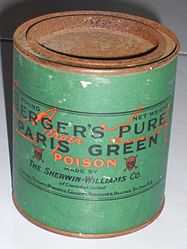Paris Green
| Paris Green | ||
|---|---|---|
 | ||
| Other names C.I. Pigment Green 21, Emerald Green, Schweinfurt Green, Imperial Green, Vienna Green, Mitis Green, Veronese green[1] | ||
| Identifiers | ||
| CAS number | 12002-03-8 | |
| PubChem | 22833492 | |
| UN number | 1585 | |
| Jmol-3D images | {{#if:CC(=O)[O-].CC(=O)[O-].[O-][As]=O.[O-][As]=O.[O-][As]=O.[O-][As]=O.[O-][As]=O.[O-][As]=O.[Cu+2].[Cu+2].[Cu+2].[Cu+2]|Image 1 | |
| ||
| ||
| Properties | ||
| Molecular formula | Cu(C2H3O2)2·3Cu(AsO2)2 | |
| Molar mass | 1013.79444 g/mol | |
| Appearance | Emerald green crystalline powder | |
| Density | >1.1 g/cm3 (20 °C) | |
| Melting point | >345 °C | |
| Boiling point | decomposes | |
| Solubility in water | insoluble | |
| Solubility | soluble but unstable in acids insoluble in alcohol | |
| Hazards | ||
| MSDS | CAMEO MSDS | |
| EU classification | | |
| R-phrases | R23/25 R50/53 | |
| S-phrases | (S1/2) S20/21 S28 S45 S60 S61 | |
| LD50 | 22 mg/kg | |
| Except where noted otherwise, data are given for materials in their standard state (at 25 °C (77 °F), 100 kPa) | ||
| Infobox references | ||
| Paris Green | |
|---|---|
| Hex triplet | #50C878 |
| sRGBB (r, g, b) | (80, 200, 120) |
| CMYKH (c, m, y, k) | (60, 0, 40, 22) |
| HSV (h, s, v) | (140°, 60%, 78%) |
| Source | [Unsourced] |
|
B: Normalized to [0–255] (byte) H: Normalized to [0–100] (hundred) | |
Paris Green (copper(II) acetate triarsenite) is an inorganic compound more precisely known as copper(II) acetoarsenite. It is a highly toxic emerald-green crystalline powder[2] that has been used as a rodenticide and insecticide, and also as a pigment, despite its toxicity. It is also used as a blue colorant for fireworks.[3] The color of Paris Green is said to range from a pale, but vivid, blue green when very finely ground, to a deeper true green when coarsely ground.
Preparation
Paris Green may be prepared by combining copper(II) acetate and arsenic trioxide.[4]
Uses
Insecticide
Paris Green was once used to kill rats in Parisian sewers, hence the common name.[citation needed] It was also used in America and elsewhere as an insecticide for produce, such as apples, around 1900, where it was blended with lead arsenate. This quite toxic mixture is said "to have burned the trees and the grass around the trees". Paris Green was heavily sprayed by airplane in Italy, Sardinia, and Corsica during 1944 and in Italy in 1945 to control malaria.[5]
Pigment
Paris Green was once a popular pigment used in artists' paints.
Related pigments
Similar natural compounds are the minerals chalcophyllite Cu18Al2(AsO4)3(SO4)3(OH)27·36(H2O), conichalcite CaCu(AsO4)(OH), cornubite Cu5(AsO4)2(OH)4·(H2O), cornwallite Cu5(AsO4)2(OH)4·(H2O), and liroconite Cu2Al(AsO4)(OH)4·4(H2O). These vivid minerals range from greenish blue to slightly yellowish green.
Scheele's green is a chemically simpler, less brilliant, and less permanent, synthetic copper-arsenic pigment used for a rather short time before Paris Green was first prepared, which was approximately 1814. It was popular as a wallpaper pigment and would degrade, with moisture and moulds, to arsine gas. Paris Green may have also been used in wallpaper to some extent and may have also degraded similarly. Both pigments were once used in printing ink formulations.
The ancient Romans used one of them, possibly conichalcite, as a green pigment. The Paris Green paint used by the Impressionists is said to have been composed of relatively coarse particles. Later, the chemical was produced with increasingly small grinds and without carefully removing impurities; its permanence suffered. It is likely that it was ground more finely for use in watercolors and inks, too.
See also
- List of colors
Gallery
| Illustrations of Paris Green | |||||||||
|---|---|---|---|---|---|---|---|---|---|
| |||||||||
References
- ↑ "Health & Safety in the Arts -- Painting & Drawing Pigments". Environmental Management Division, City of Tucson AZ. Retrieved 2011-02-07.
- ↑ "Hazardous Substance Fact Sheet". NJ Dept. of Health and Senior Services. Retrieved 2011-02-07.
- ↑ "How to Use Copper in Pyro Star Compositions to Create Blue Fireworks Stars". Skylighter. Retrieved 2011-02-07.
- ↑ "H.Wayne Richardson, "Copper Compounds" in Ullmann's Encyclopedia of Industrial Chemistry 2005, Wiley-VCH, Weinheim. doi:10.1002/14356007.a07_567
- ↑ Justin M. Andrews, Sc. D. (1963). "PREVENTIVE MEDICINE IN WORLD WAR II, CHAPTER V. North Africa, Italy, and the Islands of the Mediterranean". WASHINGTON, D.C. USA: OFFICE OF THE SURGEON GENERAL, DEPARTMENT OF THE ARMY. p. 281. Retrieved 2008-09-30.
External links
- Case Studies in Environmental Medicine - Arsenic Toxicity
- How Emerald green is made
- National Pollutant Inventory - Copper and compounds fact sheet
| ||||||||||||||||||||||||||||||||||||||||||||||||||||||||||||||||||||||||||||||||||||||||

